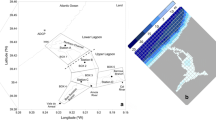Abstract
The effects of implementing Directive 91/271/EEC of 21 May 1991 (Waste Water Treatment Plan Directive) and Directive 91/676/EEC of 12 December (Nitrates Directive) are analysed in 7 Portuguese estuaries (Minho, Lima, Douro, Mondego, Tagus, Sado and Guadiana) and two coastal lagoons (Ria de Aveiro and Ria Formosa), with a modelling approach. MOHID Water Modelling System was used to perform simulations with three nitrogen load scenarios for each system: a reference scenario, a 50% nitrate removal by agriculture scenario and another with a 100% nutrients removal by waste water treatment plants (WWTP). It is shown that the interaction between hydrodynamic and ecological processes is an important feature to study trophic problems in estuaries. Ecological processes such as primary production only occur inside the system if the residence time of water is high enough to enable organismal activity and if the adequate conditions are found (e.g. light, nutrients, temperature). From the model results it is possible to conclude: (i) in systems with short residence time a reduction in nutrient load will only produce a decrease in nutrient transit and will not affect the system’s global ecological status (e.g. Douro Estuary); (ii) in systems with long residence time the effects will range from significant, when primary production is mostly limited by nutrients (e.g. Ria de Aveiro), to non-significant, when primary production in the system is light-limited (e.g. Tagus Estuary).











Similar content being viewed by others
References
Braunschweig, F., F. Martins, P. C. Leitão & R. J. Neves, 2003. A methodology to estimate renewal time scales in estuaries: the Tagus estuary case. Ocean Dynamics 53: 137–145.
Cunha, M., H. Coelho, R. J. Neves & P. C. Leitão, 2000. A numerical study of the Guadiana estuary. In Proceedings from the 3th Symposium on the Iberian Atlantic Margin. Universidade do Algarve, Faro, 27–28.
Day, J. N., C. A. S. Hall, W. M. Kemp & A. Y. Arancibia, 1989. Estuarine ecology. Wiley, New York.
De Jonge, V. N. & M. Elliott, 2001. Eutrophication. In Steele, J., S. Thorpe & K. Turekian (eds), Encyclopaedia of ocean sciences. Academic Press, London, 852–870.
De Jonge, V. N., M. Elliott & E. Orive, 2002. Causes, historical development, effects and future challenges of a common environmental problem: eutrophication. Hydrobiologia 475–476: 1–19.
Deleersnijder, E., J.-M. Campin & E. J. M. Déles, 2001. The concept of age in marine modelling. I. Theory and preliminary model results. Journal of Marine Systems 28: 229–267.
EPA, 1985. Rates, constants and kinetics formulations in surface water quality modelling. 2nd edn. United States Environmental Protection Agency, Washington.
Flindt, M. R., M. A. Pardal, A. I. Lillebø, I. Martins & J. C. Marques, 1999. Nutrient cycling and plant dynamics in estuaries: a brief review. Acta Oecologica 20: 237–248.
Grall, J. & L. Chauvaud, 2002. Marine eutrophication and benthos: the need for new approaches and concepts. Global Change Biology 8: 813–830.
Havens, K. E., J. Hauxwell, A. C. Tyler, S. Thomas, K. J. McGlathery, J. Cebrian, I. Valiela, A. D. Steinman & S. Hwang, 2001. Complex interactions between autotrophs in shallow marine and freshwater ecosystems: implications for community responses to nutrient stress. Environmental Pollution 113: 95–107.
Marsili-Libelli, S., 2003. Fuzzy prediction of the algae blooms in the Orbetello lagoon. Environmental Modelling and Software 19: 799–808.
Martins, F., R. J. Neves, P. C. Leitão & A. Silva, 2001. 3D modelling in the Sado estuary using a new generic coordinate approach. Oceanologica Acta 24, S51-S62.
Martins, F., M. P. Reis, R. J. Neves, A. P. Cravo, A. Brito & A. Venâncio, 2004. Molluscan Shellfish bacterial contamination in Ria Formosa coastal lagoon: A modelling approach. Journal of Coastal Research, special issue 39.
MOHID, 2004. Water Modelling System. Maretec—Instituto Superior Técnico, Lisbon. www.mohid.com.
Nixon, S. W., 1995a. Enriching the sea to death. Scientific American. The Oceans, 48-53.
Nixon, S. W., 1995b. Coastal marine eutrophication: a definition, social causes and future concerns. Ophelia 41: 199–220.
Pina, P., 2001. An integrated approach to study the Tagus estuary water quality. [M.Sc Thesis]. Instituto Superior Técnico, Universidade Técnica de Lisboa, Lisbon.
Pina, P., F. Brawnschweig, S. Saraiva, M. Santos & R. J. Neves, 2003. The role of physics controlling the eutrophication processes in estuaries. Thalassas 19: 141–143.
Pina, P., J. P. Delfino, P. C. Leitão & R. J. Neves, 2000. An integrated approach to study the Tagus estuary water quality. Proceedings from the 3rd Symposium on the Iberian Atlantic Margin. Universidade do Algarve, Faro, 95–96.
Portela, L., 1996. Modelação matemática de processos hidrodinâmicos e de qualidade da água no estuário do Tejo. [PhD Thesis]. Instituto Superior Técnico, Universidade Técnica de Lisbon.
Schramm, W., 1999. Factors influencing seaweeds response to eutrophication: some results from EU-project EUMAC. Journal of Applied Phycology 11: 69–78.
Smith, V. H., G. D. Tilman & J. C. Nekola, 1999. Eutrophication: impacts of excess nutrients inputs on freshwater, marine, and terrestrial ecosystems. Environmental Pollution 100: 179–196.
Trancoso, A., S. Saraiva, L. Fernandes, P. Pina, P. Leitão & R. Neves, 2005. Modelling macroalgae using a 3D hydrodynamic-ecological model in a shallow, temperate estuary. Ecological Modelling 187: 232–246.
Valiela, I., 1995. Marine ecological processes. Springer-Verlag, New York.
Villarreal, M. R., P. Montero, J. J. Tabuada, R. Prego, P. C. Leitão & P. Vicente, 2002. Hydrodynamic model study of the Ria de Pontevedra under estuarine conditions. Estuarine, Coastal and Shelf Science 54: 101–113.
Acknowledgements
This research was made possible within the framework of a project of Portuguese National Water Institute (INAG) to evaluate water quality in Portuguese estuaries. The authors would also like to thank the contributions of two anonymous reviewers.
Author information
Authors and Affiliations
Corresponding author
Rights and permissions
About this article
Cite this article
Saraiva, S., Pina, P., Martins, F. et al. Modelling the influence of nutrient loads on Portuguese estuaries. Hydrobiologia 587, 5–18 (2007). https://doi.org/10.1007/s10750-007-0675-9
Issue Date:
DOI: https://doi.org/10.1007/s10750-007-0675-9




